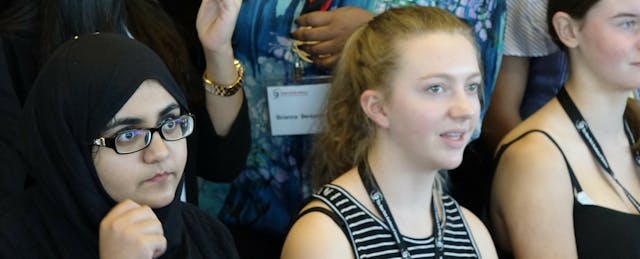For some peering into the Silicon Valley, the future of innovation seems murky—filled with gimmicky apps that silo individuals instead of bringing them together. A popular sketch, first shown in a New York Times article, reflects this bleak reality. It depicts an older gentleman asking a young adult, “When will you make something that matters?” The retort from the younger man (with his smartphone and hoodie): “When will you make something cool?”
This short conversation reflects a much broader societal concern. The fear that young people are being taught to innovate, but not taught to bring value to society with their creations. The New York Academy of Sciences (NYAS) wants to ensure that there are just as many inventors working on cancer, energy and other impactful endeavors as photo filters and dating apps.
In order to combat this issue the NYAS’ Global STEM Alliance (GSA), in partnership with the Aspen Brain Institute, created the Social Impact Challenge to encourage the brightest STEM students around the world to become billionaires—but not in the traditional understanding of the word.
“The new definition of a billionaire is a person or group of people, that can touch, teach or influence a billion people,” said Glenda Greenwald, president and founder of the Aspen Brain Institute Foundation, to a modest crowd at the GSA Award ceremony last Friday afternoon. “If each student engages in a social impact action pledge and touches ten to a thousand people each, we will soon be at 1 billion people that we can influence for social good.”
Many organizations are already working to help students become futurists, technologists, and innovators, Greenwald noted. What’s different about this effort is an emphasis on ensuring that students also became humanitarians.
“I think that people are so focused on technology and advancing technology that they forget about the impact of technology. What is it going to do to make people's lives better?” asked Celina Morgan-Standard the Senior Vice President of Global Business Development at the New York Academy of Sciences. “I think is important for all of our students to not only think about the potential of their technology to disrupt companies, but also the humanitarian impact.”

The Social Impact Challenge is hosted by GSA’s Junior Academy, a program for high-achieving STEM students from around the world. Learners work remotely with mentors through an online system created by the NYAS called Launchpad. For 14 weeks, they research and prototype development solutions for challenges modeled after the United Nations Sustainable Development Goals. Challenges include clean water and sanitation, economic growth and good healthcare. After the 14 weeks, students with winning projects are flown to New York City where they can finally meet their teammates in person and receive recognition for their work.
“We have kids from 60 countries and close to 1400 students in the program,” said Morgan-Standard. “Our vision is to create a community of problem solvers who can become the leaders of STEM in the world and develop solutions to the world’s greatest challenges.”
Competition for the program is fierce. Out of 11,000 applicants, only 1300 were chosen to join the Junior Academy, and out of those chosen, only one group won the Social Impact Challenge. They were all girls: Meghna Badami (Bangalore, India), Jennifer Cheung (from New York), Esha Datanwala (Mumbai, India) and Ria Desa (California). Each made pledges to support their local communities and reach out to other youth through volunteer work and social media campaigns.

“We thought about [our social impact pledge] for a very long time, but realized we didn’t have to look too far to find something very important to us,” said Badami.
“We pledge to help STEM interests of youth in our community,” Desa chimed in.
After receiving their Social Impact Award, the girls also presented their winning prototype for the Public Health Challenge: a Survivor Observation System for Ebola patients (also called SOS-E). To create the system, students identified the symptoms of Ebola patients. Then they designed wearable, solar-powered contact lenses and wristbands that worked together to alert possible victims (using a light system) to visit a local hospital if the technology detected changes in close relation to Ebola symptoms (such as changes to PH levels in the bloodstream and fluctuations in intraocular pressure).

“All of us are familiar with what Ebola is, but little do we know that even after people are cured of the disease, or they think they are cured, they are not actually. The symptoms start coming back and haunting the survivors,” Badami told the audience in New York City.

The high representation of girls and minorities in the Junior Academy is part of a larger push from the group to diversify the STEM field. The program is 60 percent female, and 40 percent of the students come from outside the United States. Other programs under GSA, including 1000 Girls 1000 Futures, highlights the organization’s commitment to diversifying the STEM pipeline. Nicholas M. Donofrio, former executive vice president of innovation at IBM who keynoted the event, notes that increasing diversity and equity is both a business and moral benefit.
“My thoughts about inclusion may sound moral and ethical, but that’s not why I am saying it. I am saying it because it makes sound business judgement to be inclusive,” said Donofrio. “We have been shown that when we cut out a certain class of people from the thinking process, we suffer the consequences. The problems that are worth solving and the value that is worth creating lies at the intersection of things, not in one silo.”


